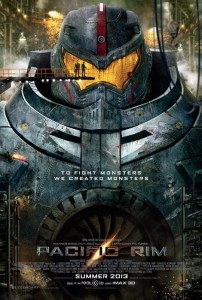
 “Pacific Rim” is epic. That was the conclusion of my 11 year old, and I tend to concur. It isn’t a transcendent film but should serve to revitalize the monster movie genre. And that’s a good thing.
“Pacific Rim” is epic. That was the conclusion of my 11 year old, and I tend to concur. It isn’t a transcendent film but should serve to revitalize the monster movie genre. And that’s a good thing.
Criticizing director Guillermo del Toro’s “Pacific Rim” could be seen as petty. It is, after all, an unabashed monster movie opus in the “classic” tradition. And it is ridiculous, completely and utterly preposterous, even though a concerted effort is made to sell the story to the viewer. But the foolishness pervasive throughout doesn’t matter. Exciting and stylish director del Toro’s loving send up of the monster movie wears its cheesy veneer as well as the gargantuan armor surrounding the film’s robotic heroes.
The story is thin: Earth is invaded by large beasts that emerge from the depths of the ocean. A rift has developed between two worlds linking us with another and through the opening we are attacked by horrible monsters. These creatures terrorize coastal cities leaving massive destruction in their wake. Fighting them by traditional means proves to be difficult. And while our armies can take the beasts down, they do so slowly and the costs are very high. Loss of life and property is excessive. Enter the Jaeger program in which huge robots are built to battle the monsters mano y mano. It is, in a word, EPIC.
But after some success, the monsters (called “Kaiju”) progressively get harder and harder to beat. And the Jaeger program is in danger of being scrapped in favor of building giant walls around the coastlines. When Jaeger pilot Raleigh (Charlie Hunnam) loses his co-pilot in a clash with a new improved monster, he retreats to a life as a construction worker–high upon one of those coastal walls. Inevitably, he will return to the pilot’s seat to do do battle, and Earth’s future will hang in the balance.
Director del Toro does a wonderful job setting up all the story elements so that he can have fun with the impressive special effects. The melodrama is weak but above-average or on par with what you’d expect from the b-movie genre. The effects, on the other hand, are top-shelf. The monsters are sufficiently terrifying while still respectful of the Godzilla movies that act as the film’s inspiration.
It helps that the casting is up to the soapy requirements. Idris Elba (of the BBC’s “Luther”) delivers the rousing but perfunctory speech to his men before the grand final battle, and Hunnam plays his character straight and sincerely. In fact, Hunnam’s somber take feels understated and appropriate for the material. This gives lovely Japanese actress Rinko Kikuchi (see “Norwegian Wood”) a chance to develop without being overshadowed by what could have been an arrogant hot-shot performance by Hunnam. And she has a great origin story, which almost elevates the comic material above its cheesy aspirations. As we have come to expect from a del Toro production, Ron Perlman (“HellBoy”) makes an appearance playing a character that is obviously written for his particular talents. Charlie Day (“It’s Always Sunny in Philadelphia”) and Burn Gorman (“Torchwood”) play two goofy scientists who give us solid comic relief.
But I do have criticisms of “Rim.” First, intellectually, the technology is wildly inconsistent. The robots are just plain ridiculous from the on-set, but their construction and make-up are a nutty combination of steam-punk and future-think. And one of the film’s high-brow ideas, that of the “drift,” proves to be one of it most frustrating plot points. The pilots of the Jaegers (the robots) have to be twinned, meaning that not just one pilot can man the machine. And to be truly effective, the pilots must not only possess great fighting skills but be able to link into the other pilot’s mind (hence “drift”). The two become one. Okay, this all sounds cool, but in practice it is a bit of a mess. The pilots for some reason must actually inhabit the robots, instead of manning them from remote, and if one of them is hurt or killed, the robot cannot be properly controlled. I suppose that even with all the marvelous technology on display, no genius has bothered to develop an autopilot.
Second, the battles are shot at night and often in the rain. This means that the special effects are shown in virtual darkness. Old CGI was given to us this way and makes it really hard to appreciate the true quality of the effects–darkness hides problems. Say what you want about “The Hobbit” and “Man of Steel,” but the effects were shown in the bright light of day. In “Pacific Rim,” is it as though del Toro throws us back not only to the time of cheesy monster movies but also to a time before filmmakers had complete confidence in CGI. And add to this a visual scope that places the viewer inside the action in which very few wide shots provide context as to who is winning the pitched battle. Some viewers will be frustrated.
But aside from some nit picky complaints, I enjoyed “Pacific Rim.” In fact, it is one of the best tentpoles I’ve seen this year. It’s perfect viewing for a father and a son, and mothers and daughters should get a kick out it too.
